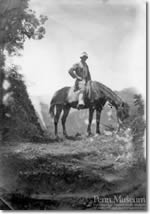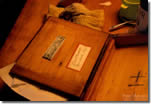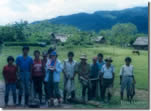
It all started in the last millennium, when I was looking for information on an object in Penn Museum's Mesoamerican gallery, and rooting through what was then the American Section archives-several four drawer file cabinets that were full to bursting, and out popped a letter from the Reverend T H Parsons, of Athenry, Ireland, dated in the 19 teens, asking about his son, Robert Burkitt, who worked in Guatemala for the Penn Museum, and with whom he had lost touch. Robert Burkitt -- who died in 1945, sent more than a thousand items back to the Museum, where most of them remained out of sight in storage for more than half a century. My interest in Burkitt led me from a general interest in the Maya, into Burkitt's work and collections. He did most of his excavating in the Guatemalan highlands.
And since my husband and I were planning a vacation in Guatemala, we decided to drop in on the old Burkitt neighborhood. It was really luck that we connected with Edgar Champney, descendant of Burkitt's friend, the owner of Sepacuite ranch. This is the ranch where Burkitt was said to have arrived in time for tea, and stayed for 30 years. The owners even built him a guest house to live in. The ranch was still in the family, and Edgar took us there.

Edgar Champney's teenage daughter Rebeca and I dug into boxes and papers that had been sealed for more than 30 years and amid ranch records and old invoices I found some of his papers, all that was left of his life's work. His linguistic notebooks, some family letters, articles, photographs, a handdrawn family geneaology…the stuff of research and memories. I was really hooked.
I brought back everything, packed in plastic bags! After Conservator Ginny Greene had put it all through fumigation to get rid of the bugs, some went directly to our Archives while others provided food for my growing Burkitt mania.
My interest in Burkitt led to a serious interest in Maya pottery. I began researching Chama polychromes, named for the site where they were first excavated. Turns out he excavated and sent to the museum the only group of such vessels with provenience in this country. Other Chama polychromes are-shall we say-not scientifically excavated.
Along the way I discovered our amazing collection of water colors of Maya pots, including the Burkitt polychromes painted by M. Louise Baker, the resident artist at the museum from 1908 to 1936, when poor eyesight forced her retirement. These two people, each very idiosyncratic and perhaps a bit acerbic, met when the Museum sent Baker to Mexico and Guatemala to paint outstanding Maya pottery, and suggested that Burkitt keep an eye on her. Perhaps not surprisingly, they liked each other. He would visit and keep her company while she painted, and always brought her chocolate drops in a little canvas sack.
I came into contact with Baker's family through her great niece, Leslie Coke; they gave me permission to read Baker's fifty years of diaries, and to make copies of those diaries for our archives. A FAMSI grant enabled us to scan all of her Maya water colors, and put them on the web, along with a biographical sketch of this remarkable woman.

In 1999, along with Guatemalan archaeologist Vilma Fialko, I flew from the Guatemalan provincial capital of Coban in a not-so-hi-tech plane to the village of Chama, where we were met by some of the almost 200 families living there. One of the purposes of the trip was to obtain raw clay which Ron Bishop of the Smithsonian would subject to neutron activation analysis for comparison to the clay in Chama polychromes, to help identify the source of the raw materials used.
When I first broached the subject of an exhibit, it was going to be just the polychromes, as beautiful objects. But as we all know, things have a way of changing. And some of the discoveries made during the process of conservation altered and enriched the basic premise. Some of the vessels were found to have contained cacao beverages, some had been repaired carefully in antiquity, another held the fingerprint of the ancient artist.
And so the exhibit grew, and changed. The polychromes now hold pride of place not merely as objects of beauty, but as symbols of the political change that I believe they represent. The inclusion of other artifacts Burkitt excavated bring added dimension to a story of the Maya told through the objects. The themes of the exhibit arise out of them.
The exhibit itself deals primarily with objects excavated in and around the site of Chama along the Chixoy River, in the Alta Verapaz, a region that's geographically between two well researched geographic areas. The western highlands of Guatemala, where anthropologists have focused on the living traditions of the Maya, and the archaeology of the Post Classic centers, such as Zaculau, dating from about 1200 to the time of the conquest. The other region, of course includes, the lowland regions of the great Maya cities of antiquity, such as Piedras Negras and Tikal in Guatemala, Caracol in Belize, and Copan in Honduras, all sites excavated by the Penn Museum.
The Museum's exhibition department - Kate Quinn and Aaron Billheimer - have created an organizational plan that enhances the concept of interaction and provides visual excitement through variation. Visitors explore the theme of Symbols of Power by looking through windows, walking through doors to view defined areas that highlight sub themes such as warfare, hierarchy, writing.
Many wonderful projects have grown from this exhibition. Burkitt's word lists that I rescued from the barn at Sepacuite, have just been published thanks to the superb work of John Weeks at the Penn Museum Library. The Chama vessels and many of his other objects are conserved for the foreseeable future, thanks to Lynn A. Grant. An exhibition of Baker's paintings and a full scale biography of the artist is planned as well as the publication of a full scale biography of Burkitt. I like to think that Burkitt and Baker would be happy with the results of my Burkittmania.


